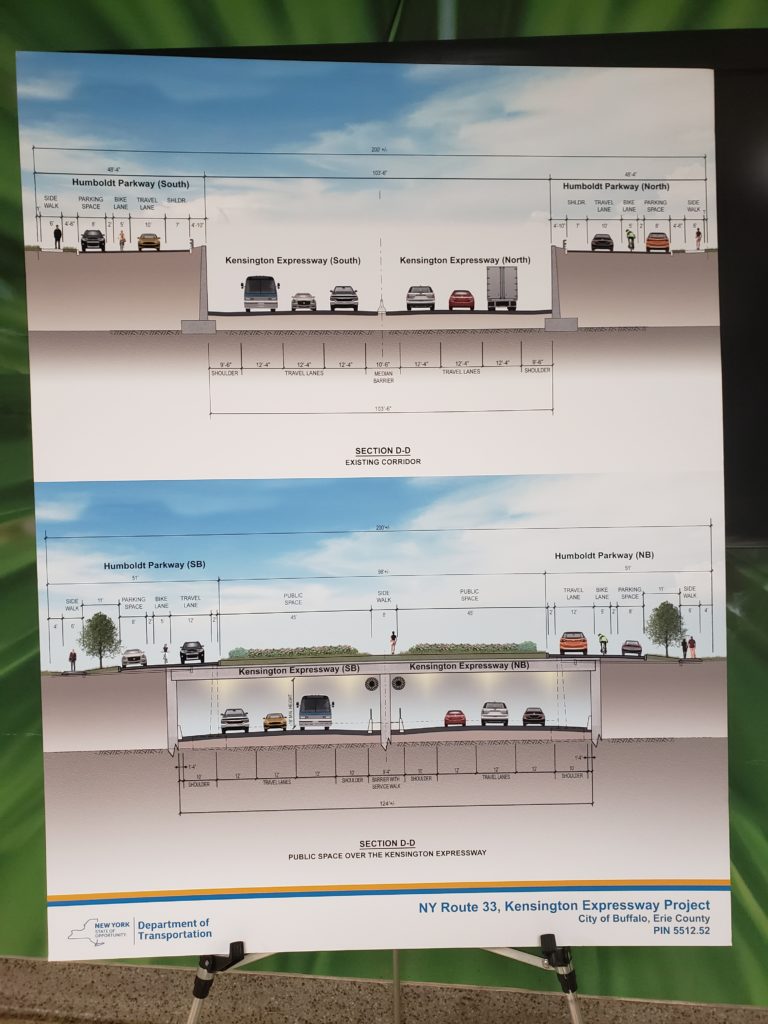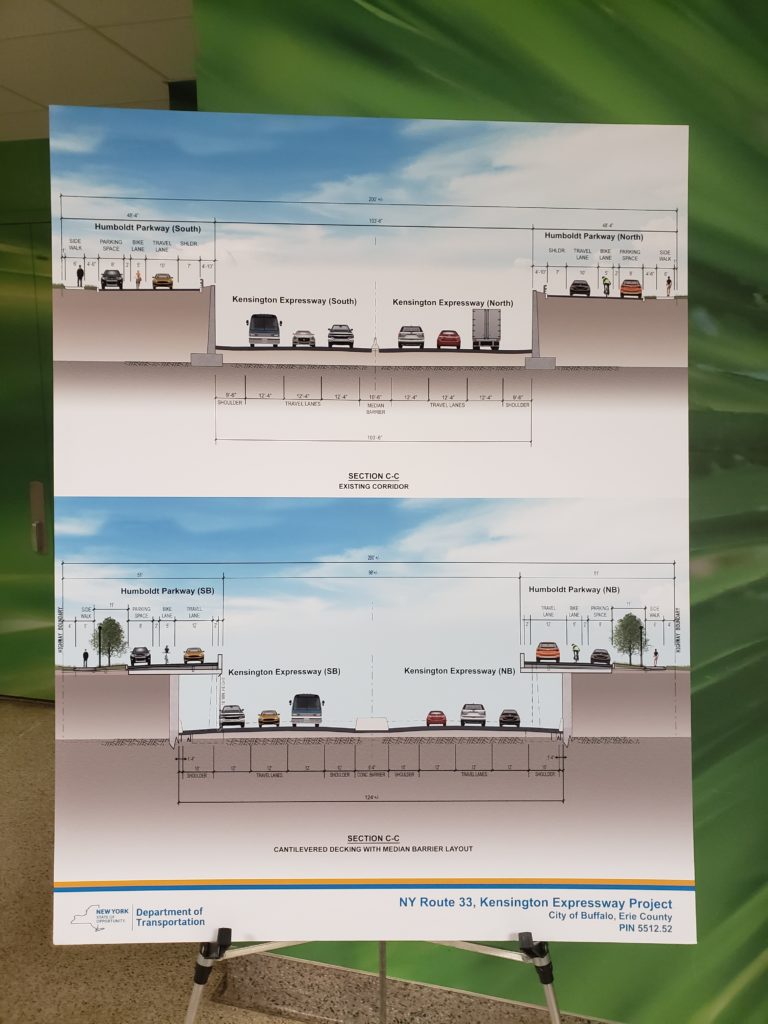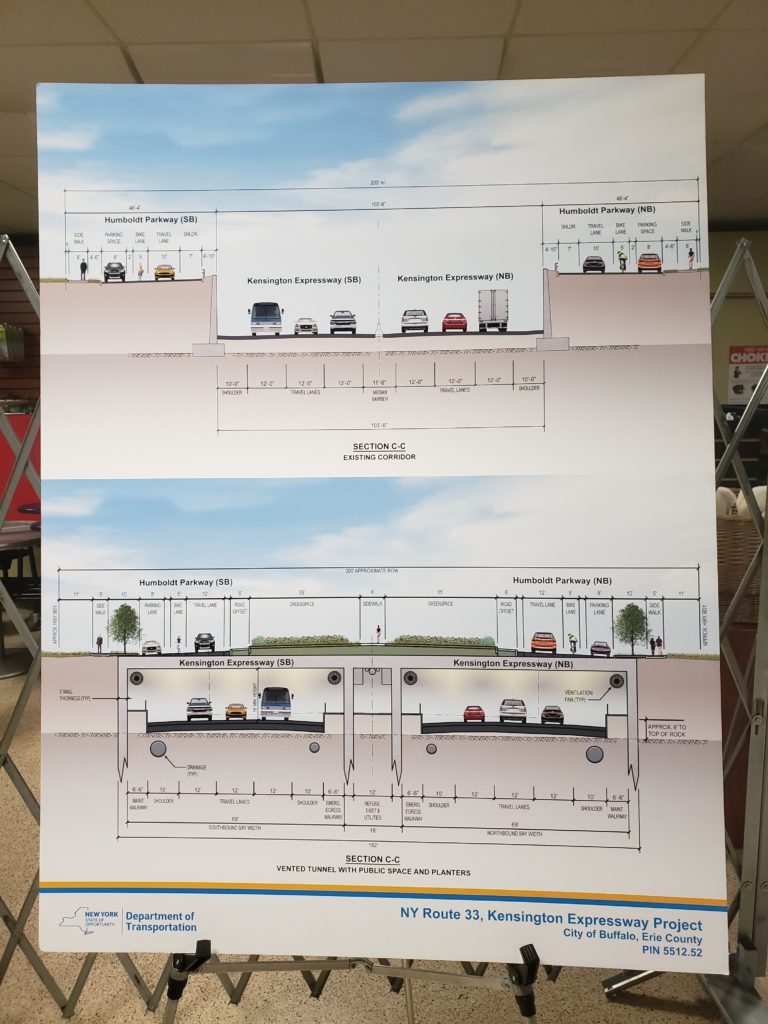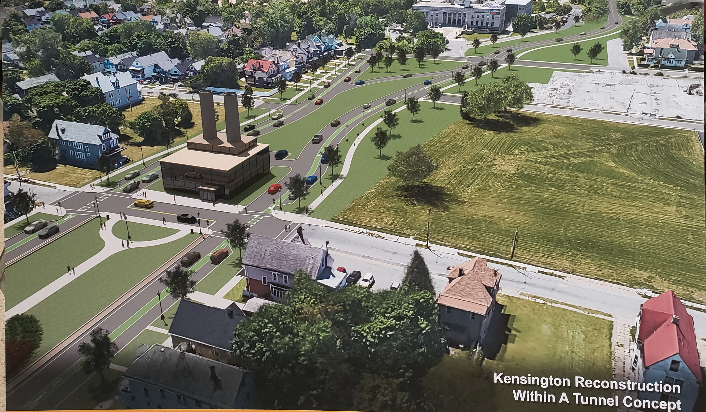By Kevin Heffernan
It doesn’t get more tone deaf than the DOT
It might be time to rebrand the New York State Department of Transportation. They’re not really deserving of the umbrella “Transportation” term. Maybe Department of Move Cars Faster, or Department of Keep it 1980. Department of Cars. Department of Pollution Status Quo. Any of those will do after Wednesday night’s meeting when Albany’s top brass faced off against 200+ in attendance at the Buffalo Museum of Science to present options dealing with the Kensington Expressway between Best and Ferry (yet another incomplete plan for a major thoroughfare). Restore Our Community Coalition (ROCC) has been working for nearly 20 years to get to this point.
By now, you’ve seen the photos, or you have parents, grandparents who can tell you what Humboldt Parkway used to look like. If not, think Bidwell Parkway, because that’s exactly how it looked. Massive trees provided shade over the grassy path that connected both Delaware Park to MLK Park, and the houses across the street to one another.
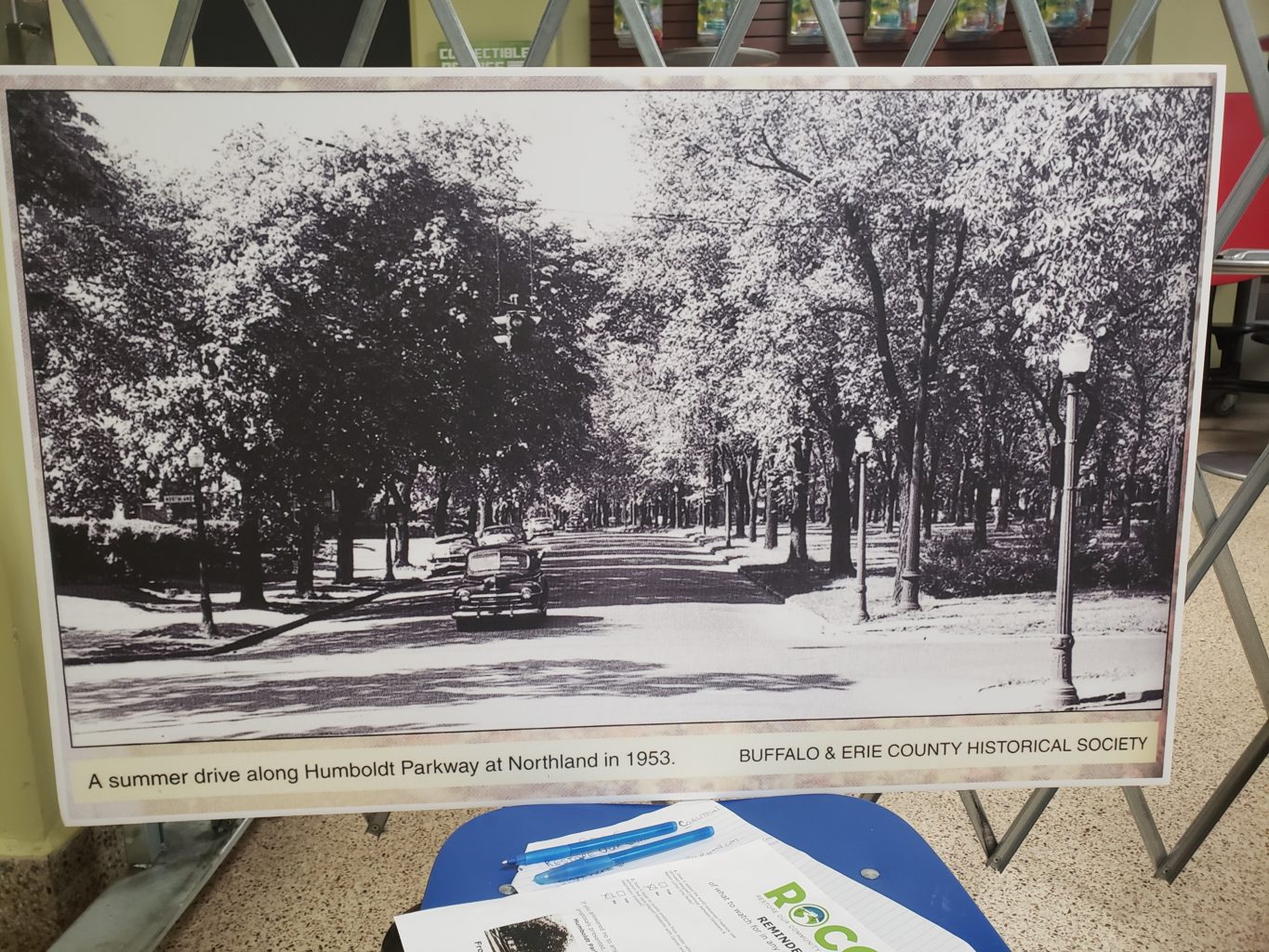
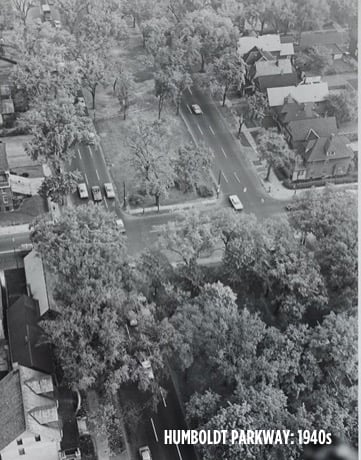
We all know what happened next. White flight, powered by government and bank policies put in place to give loans to white families to build wealth in the suburbs, and the same policies kept loans out of reach for black families heavily concentrated in certain areas of the city, along Humboldt Parkway for one.
With the loss of white people and their wealth to the suburbs, the city panicked at the thought of losing their businesses from downtown as well. It was decided that high speed super highways should stripe the city in order to allow suburban commuters the fastest possible way into work so that they wouldn’t dare think about opening up shop in Amherst (where thousands of jobs were indeed shifted anyways).
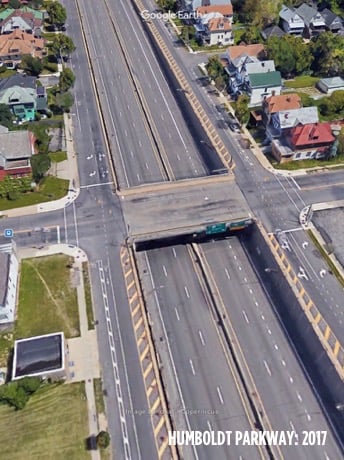
How would you like to have your front yard turned into a 6+2 lane highway with all the noise and pollution that comes with it, when you used to have a park? The residents of these neighborhoods that were literally gutted by one of Buffalo’s biggest mistakes were and remain angry. Rightfully so. To see a wider history of these neighbors and how they’ve banned together and their mission, check out an article for the very first edition of No Boundaries magazine, written by Bradley Bethel.
Senator Tim Kennedy expressed his support for this work, “There are multimillion dollar infrastructure projects happening all over this state and this country and Buffalo deserves to have one too!” NYS Assembly Majority Leader Crystal Peoples Stokes commended ROCC for their efforts, and proclaimed her excitement for the progress we’d be about to see. After the plans were revealed, both politicians failed to denounce them as not nearly good enough.
In no more than four minutes, NYSDOT Deputy Chief Engineer Rick Wilder ran through six planned options, really only discussed two of them, and then shut the projector down for Q&A. Here’s our best shot at breaking them down, considering their brief screen time, and the fact that naturally, the slides aren’t available online.
Essentially, all but two solutions were tossed to the side by DOT as uninteresting or not feasible. What remained was a partial capping of certain sections between Best and Ferry, a full capping requiring some heavy duty ventilation construction, and an upgraded full cap that digs deeper down so that trees, not just grass, could be planted on top.
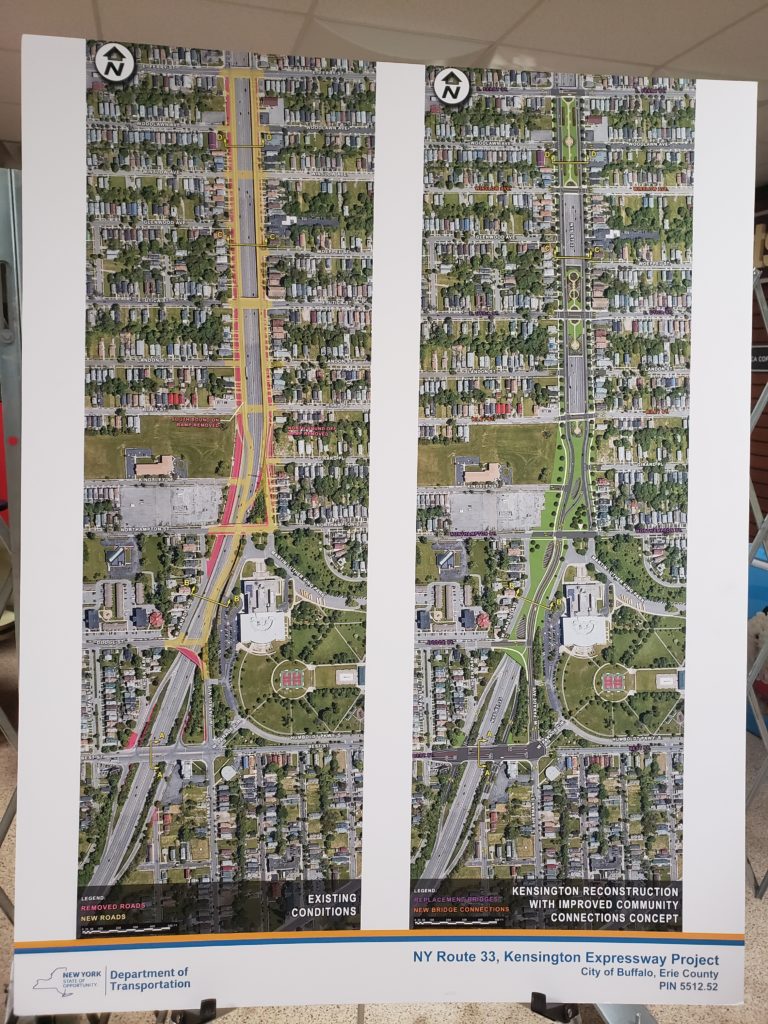
The half (assed) cap
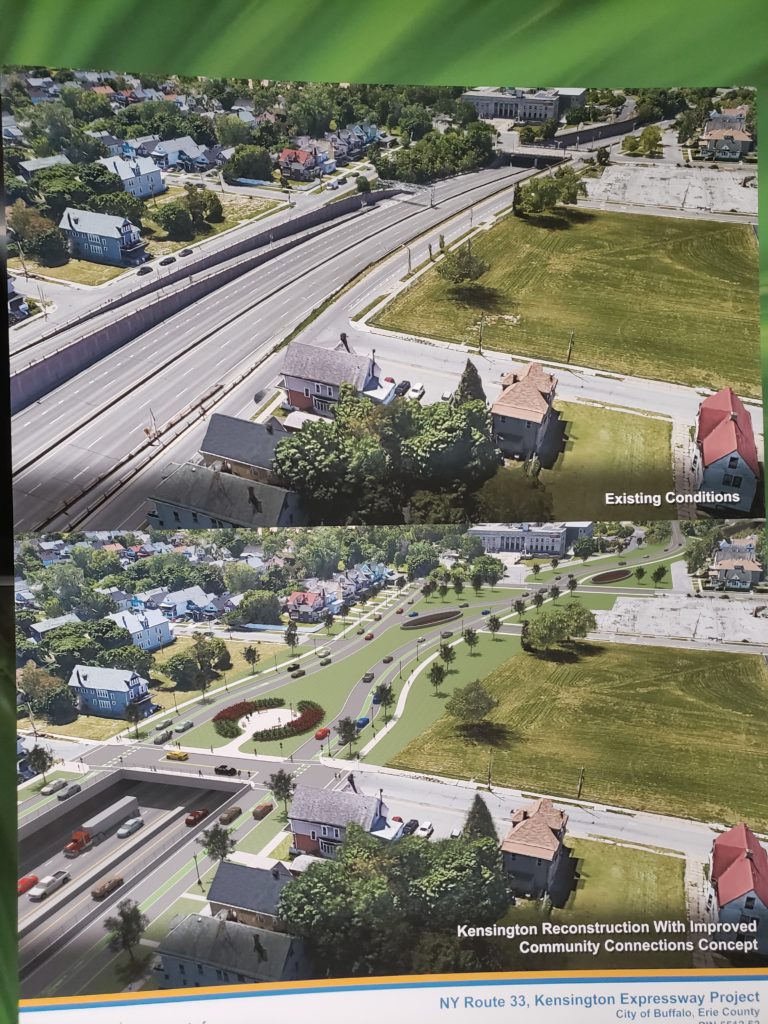
Presented, like the others, as part of an effort to reconnect a devastated community, the half-cap is the most financially feasible at around $300,000,000 in costs. It includes putting a grass-only depth cap over every few blocks and letting open air above the expressway remain in place for the unlucky blocks in between.
What’s different for the neighborhood is that the upper level for cars would now jut out about 1 car length over the expressway, giving homeowners an extra six feet of lawn between them and the road. Not insignificant, but not a massive shift either. Surprise, we’re talking about the 2020’s and the bike lanes will still be sandwiched between texting drivers and parked cars ready to open their doors without looking. That’s the DOT we know and love. Random pits will also line the capped areas to let the smog loose from the mini tunnels, right back into the neighborhoods already suffering the health effects from the expressway.
The full cap (from Best to Ferry only so not really full)
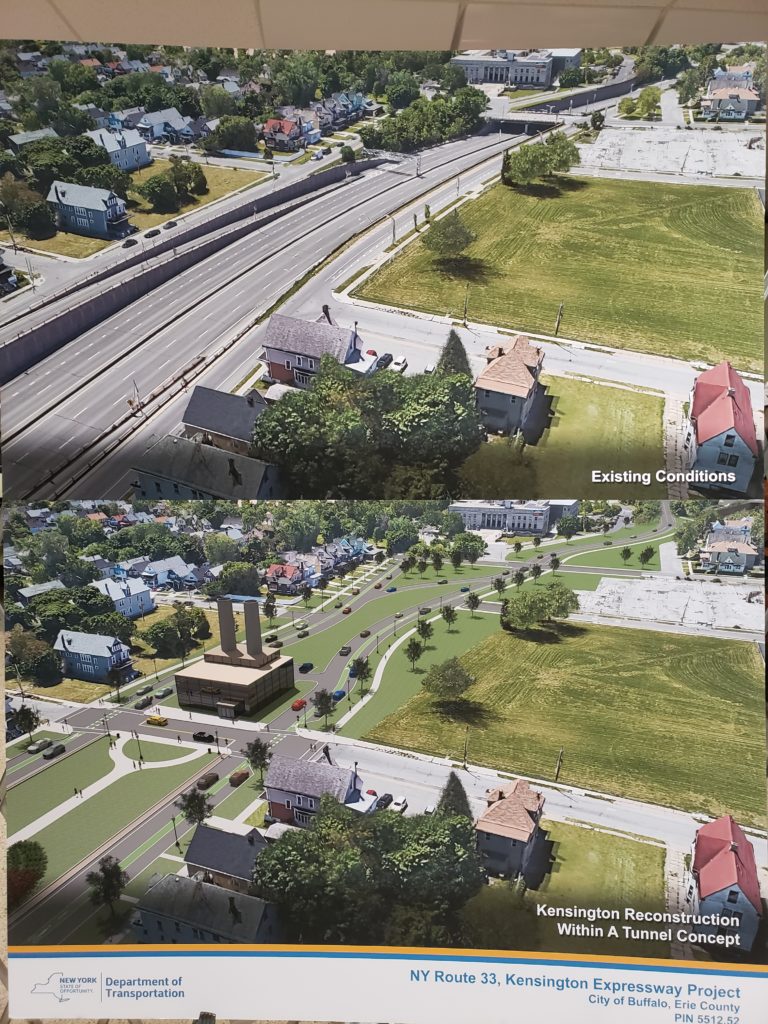
The full tunnel had previously been considered a middle ground for urbanists who wanted to at least pretend the 33 wasn’t there and the commuters who wanted it to be 65. What had not been fully considered to this point was the emissions that still exist when cars are moving through there all day every day. Wilder admitted to the crowd that the disgusting ventilation apparatus you see plopped in the middle of the “Reconnecting this neighborhood” zone was meant to clean the air for drivers in the tunnel and wouldn’t do much for the surrounding neighborhood’s air quality. BECAUSE CARS, am I right?!
Jack the price up to $580M and you have an aesthetic solution for a short stretch of land, but nothing done to improve emissions in the area, and no real return of trees to the parkway. For a quick $90M more, the DOT offered to dig the expressway deeper so the cap could also be deeper, allowing for full/mature trees. $670M and we’ve only covered 3/4 of 1 mile.
This was the end of the presentation and on came the questions.
“So… you didn’t bother to study or plan removing the whole expressway and restoring Humboldt to what it was?”
Was the first question, met with screams, whistles and raucous applause from the crowd. All the DOT could say, over and over and over again was that 70,000 vehicles use this expressway daily. To which the crowd shouted, “They can take the bus!” to cheers.
Hand after hand went up wondering what would be done about air quality for residents. DOT deflected saying they’re concerned with moving cars and that through tighter efficiency standards (now being gutted by the Trump administration for unknown reasons), emissions have gone down over the years.
There was frustration in the air as this was clearly a room full of city residents, being told by the DOT that suburban commute times were more important than air quality, and quality of life in the city. Those familiar with the positive effects seen in other cities who have torn out their urban expressways asked the DOT if they had any plans to make improvements on the ELEVEN main arterials that were initially built wide enough to handle suburban entry into and exit from the city. Streets like Niagara/Tonawanda, Elmwood, Delaware, Main, Kensington, Genesee, Sycamore/Best/Walden, William, Clinton, Seneca, South Park, and Ohio. The DOT admitted to having no such wider plan in place.
Members of the crowd asked why 70,000 vehicles on Rt 33 must be a guarantee when there are those arterials, and there’s opportunity to install light rail that can move over 550 people every 10 minutes. People asked whether this entire transportation plan was made for cars or people, and when human health was going to be a consideration. There was especially outrage over the thought that if this thing must remain, it would be easy to slap light rail right on to it, but the thought apparently never crossed DOT’s mind.
As the crowd turned from frustrated and confused to angry, Peoples Stokes stepped in to remind people that ROCC has been working for something, anything to change in this area for so many years and that just because we want everything, doesn’t mean we shouldn’t allow something to happen now. A solid point. I don’t live in this neighborhood, and I can understand the allure of something instead of nothing when nothing has been the status quo for 60 years. She conceded that if we walked away from the evening with nothing but resolute people and organizations determined to develop a master transportation plan for Buffalo, then so be it, that’s what we should do.
Car ownership is trending down across the country. An expansion of light rail is long overdue in this city and region to bring suburbanites into the city in a cleaner and more efficient way. $670M is a lot of money to spend on a short track, especially when it may only be a temporary solution that does nothing to improve the health of the residents in the name of getting into work in 20 minutes instead of 30.
Buffalo metro is 1M people. The city plus its suburbs open up more opportunity than the city alone. We’re all in this together. But over the last few decades, especially during the Brown Administration, it’s been a very lopsided relationship in favor of the suburbs in terms of expressways and parking lots, subsidies and more. No one forced anyone in the suburbs to move where they did, and no one’s saying they should abandon their towns and all come back to the city. But at some point, you cannot have it all. The city taxpayers already subsidize county infrastructure that suburban towns cannot afford, yet keep building. The city residents have lost their direct access to the waterfront thanks to the 190, they’ve lost their parkways and their health thanks to the 33, and for what? The city of Buffalo is the cultural and economic center of this region. Just as the city does benefit from suburban workers, the suburbs are far worse off when the city doesn’t succeed. It’s time the city stopped making every sacrifice possible for shortened commute times and took back what it gave up with a vision for the future, not of 70,000 cars today. Fill this thing in and bring back the parkway the way Olmsted intended.
Here’s some more pictures from the Rt 33 Racetrack:
